Top 10 AI Inferencing Platforms in 2024
Building Large Language Model applications has been increasing in popularity — streamlining business operations, automating mundane tasks, and uncovering deep insights — we’re able to do this faster than ever thanks to their ability to understand and generate natural language.
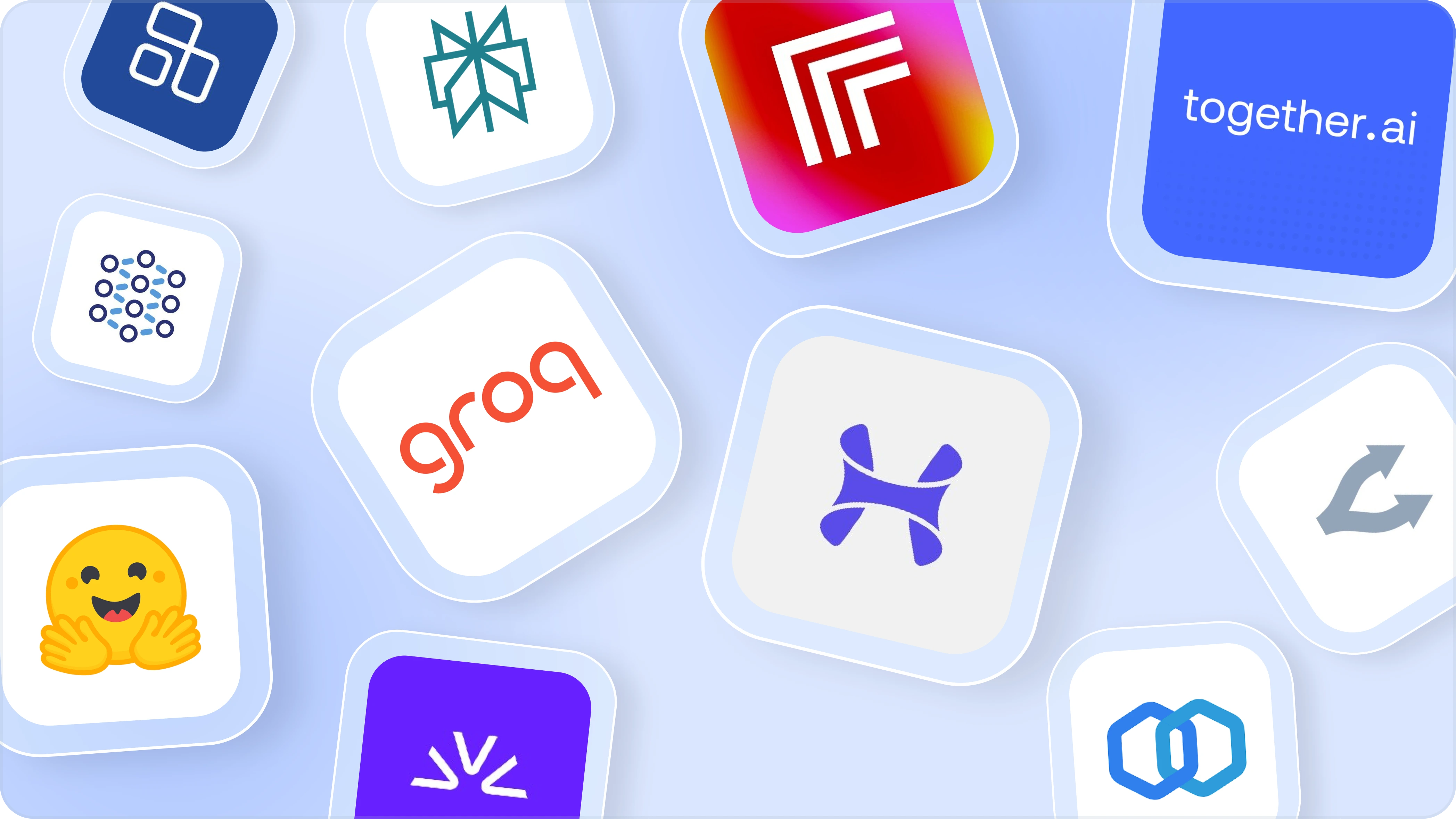
Choosing the right API provider is a critical decision to building robust LLM apps. In this guide, we will compare leading API providers like Together AI, Hyperbolic, Replicate, HuggingFace, and more based on performance, pricing and scalability. If you are looking for affordable alternatives to OpenAI, we hope this guide will help you make an informed decision.
Overview
| 1. Together AI | 7. DeepInfra |
| 2. Fireworks AI | 8. OpenRouter |
| 3. Hyperbolic | 9. Lepton |
| 4. Replicate | 10. Perplexity AI |
| 5. Hugging Face | 11. Anyscale |
| 6. Groq |
1. Together AI
Best for: Training massive language models from scratch or fine-tune existing ones, or where high performance, privacy and scalability is important.
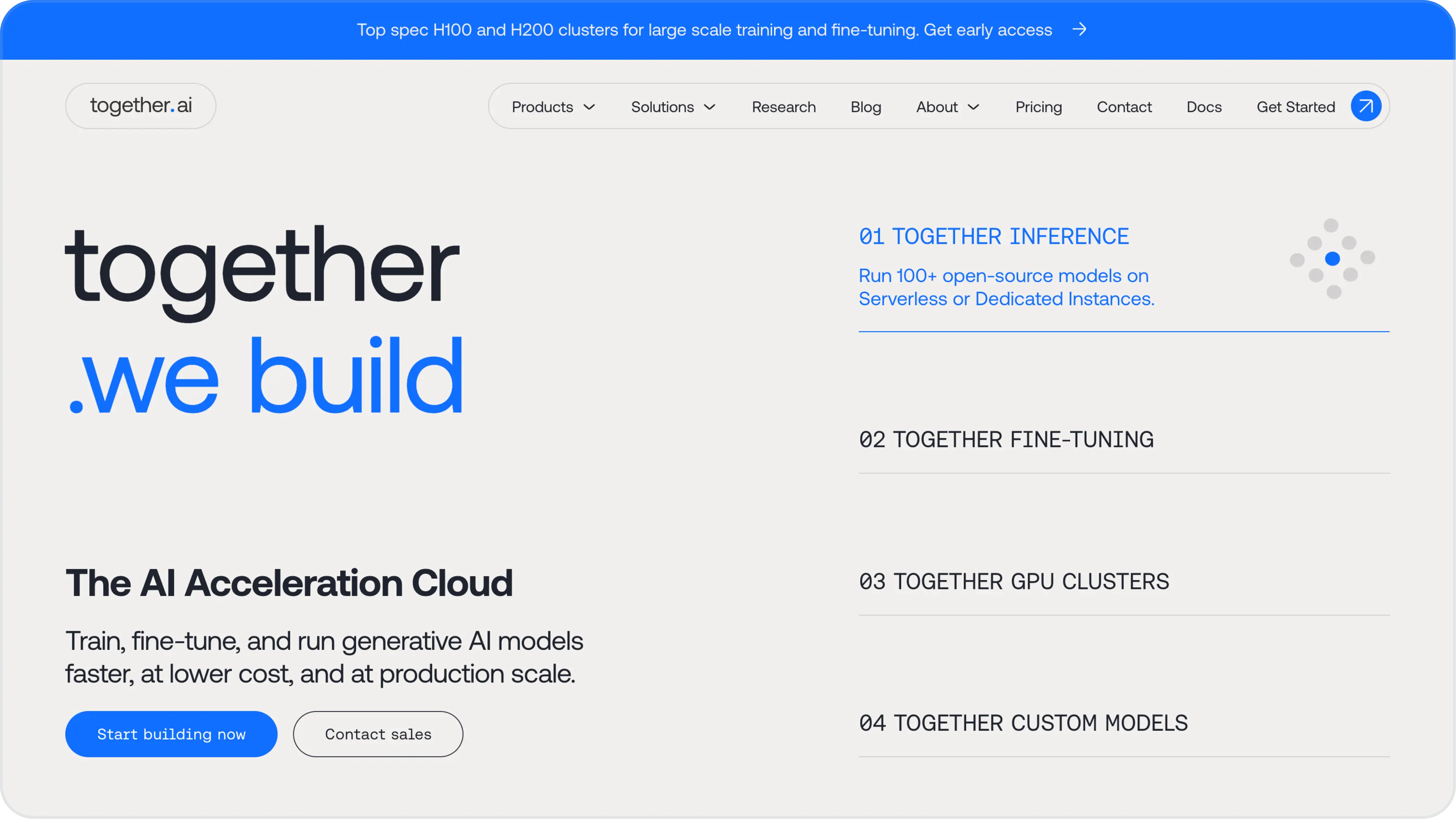
What is Together AI?
Together AI is one of the most popular cloud-based platform for training and deploying open-source LLMs. Together challenges rivals like OpenAI by winning on price, faster inference, and automatic system optimization and scaling. Together also makes it easy to fine-tune open-source models with a few lines of code. Get started.
Why do companies use Together AI?
High-quality responses, faster response time, and lower cost. Fine-tuned open-source models outperforms competitors by up to 4x (2x for Amazon Bedrock and Azure AI). Faster tokens per second, higher throughput and lower time to first token. Together is 11x lower cost than GPT-4o when using Llama-3 70B. Supports 100+ leading open-source Chat, Multimodal, Language, Image, Code, and Embedding models available through the Together Inference API.
Together AI Pricing
Free to start. For serverless models, pay for what you use (per token/image). For running models on your own private GPU, it’s a pay-per-second usage model. Enterprise tiers available.
Bottom Line
Together AI is ideal for developers who wants access to a wide range of open-source models. With flexible pricing and high-performance infrastructure, it’s a strong choice for companies that require custom LLMs and a scalable solution that is optimized for AI workloads.
Once you build an LLM app, how do you track performance?
Helicone helps you monitor your application performance, analyze complex multi-step workflows, and improve your LLM prompts with Experiments. Join the waitlist.
2. Fireworks AI
Best for: Running state-of-the-art, open-source models with speed, quality, and scalability.

What is Fireworks AI?
Fireworks AI has one of the fastest model APIs, high performance and cost-efficient, suitable for companies looking to scale. Fireworks offers serverless models such as text API, embeddings API, image API and audio API on the optimized FireAttention inference engine. They also offers on-demand deployment as well as fine-tuning text models to use either serverless or on-demand. Get started.
Why do companies use Fireworks AI?
Fireworks makes integrating state-of-the-art multi-modal AI models like FireLLaVA-13B for applications that require both text and image processing capabilities easy. Fireworks AI has 4x lower latency than other popular open-source large language model (LLM) engines like vLLM, and ensures data privacy and compliance requirements with HIPAA and SOC2 compliance.
Fireworks AI Pricing
All services are pay-as-you-go.
Bottom Line
If you’re looking for a provider that offers personalized support and scalable services, Fireworks can be a good match.
3. Hyperbolic
Best for: Companies or AI Researchers looking to reduce cost on APIs or rent high-performing GPUs.

What is Hyperbolic?
Hyperbolic is a platform that provides AI inferencing service, affordable GPUs, and accessible compute for anyone that interacts with the AI system — AI researcher, developer, and startups to build AI projects at any scale. Get started.
Why do companies use Hyperbolic?
Performance, Price & Ecosystem: Hyperbolic provides access to top-performing models for Base, Text, Image, and Audio generation at a fraction of the cost (up to 80%) of traditional providers without compromising quality. They also guarantee the most competitive price on GPUs compared to large cloud providers like AWS. To close the loop in the AI ecosystem, Hyperbolic partners with data centers and individuals on idling GPUs.
Hyperbolic Pricing
The base plan is free to start, catered to startups and small to medium-sized enterprises that need higher throughput and advanced features. Premium pricing model geared toward academic and advanced enterprise use.
Bottom Line
Hyperbolic’s strength lies in providing both inference access and compute at a fraction of the cost. For those looking to serve state-of-the-art models at a competitive price or research-grade scaling, Hyperbolic would be a suitable option.
4. Replicate
Best for: Rapid iteration and prototyping of of machine learning models. Developers can run and fine-tune open-source models and deploy custom models all with one line of code.
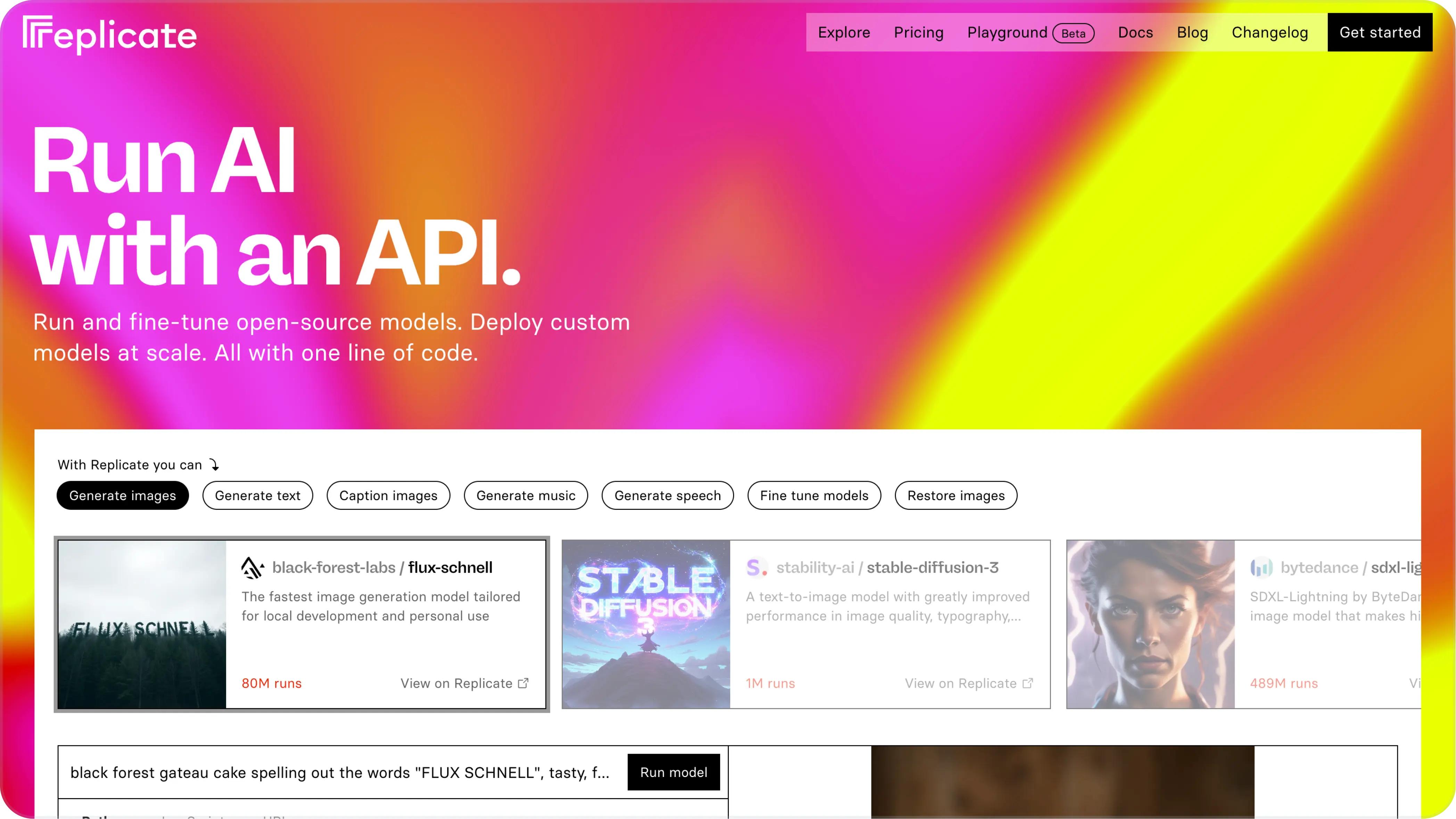
What is Replicate?
Replicate is a cloud-based platform that simplifies machine learning model deployment and scaling. Replicate uses an open-source tool called Cog to package and deploy models, and supports a diverse range of large language models like Llama 2, image generation models like Stable Diffusion, and many others. Get started.
Why do companies use Replicate?
Speed, Simplicity & Diverse Applications: Replicate is great for quick experiments and building MVPs (model performance varies based on user uploads), and getting started with an open-source model requires just one line of code. Replicate also has thousands of pre-built, open-source models covering a wide range of applications like text generation, image processing and music generation.
Replicate Pricing
Based on usage with a pay-per-inference model.
Bottom Line
Replicate is a great choice for experimentation and for developers who want speedy access to a variety of models without the hassle of setup and deployment. Replicate scales well for small to medium workloads but may need extra infrastructure for high-volume apps.
5. HuggingFace
Best for: Getting started for NLP projects, finding an open-source model from an extensive library.
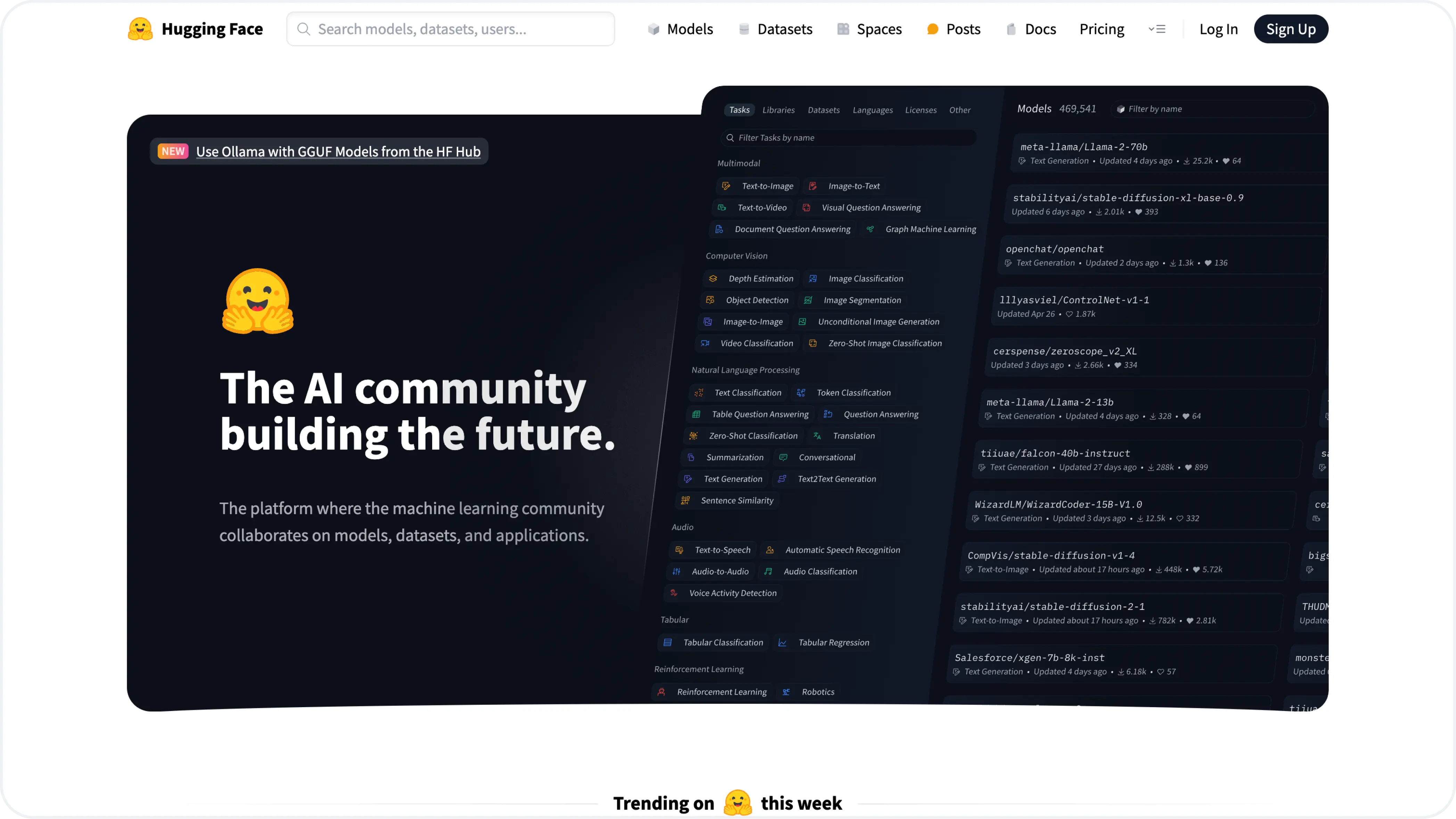
What is HuggingFace?
HuggingFace is an open-source community where developers can build, train, and share machine learning models and datasets. It’s most popularly known for its transformer library. HuggingFace makes it easy to collaborate, and it’s a great starting point for many natural language processing (NLP) projects. Get started.
Why do companies use HuggingFace?
- Extensive Library & Community: HuggingFace has an extensive model hub with pre-trained models (over 100,000 models including BERT, GPT, and more). HuggingFace also integrates with various programming languages and cloud platforms, providing scalable APIs that easily extend to services like AWS.
HuggingFace Pricing
Free for basic usage; paid plans for enterprise-level support and high-volume usage.
Bottom Line
Hugging face is a great library for fine-tuning models and AI inferencing using pre-trained models — which is useful for many NLP use cases. It has a strong emphasis on open-source development, so you may find inconsistency in documentations, or have trouble finding examples for complex use cases.
6. Groq
Best for: Getting started for NLP projects, finding an open-source model from an extensive library.
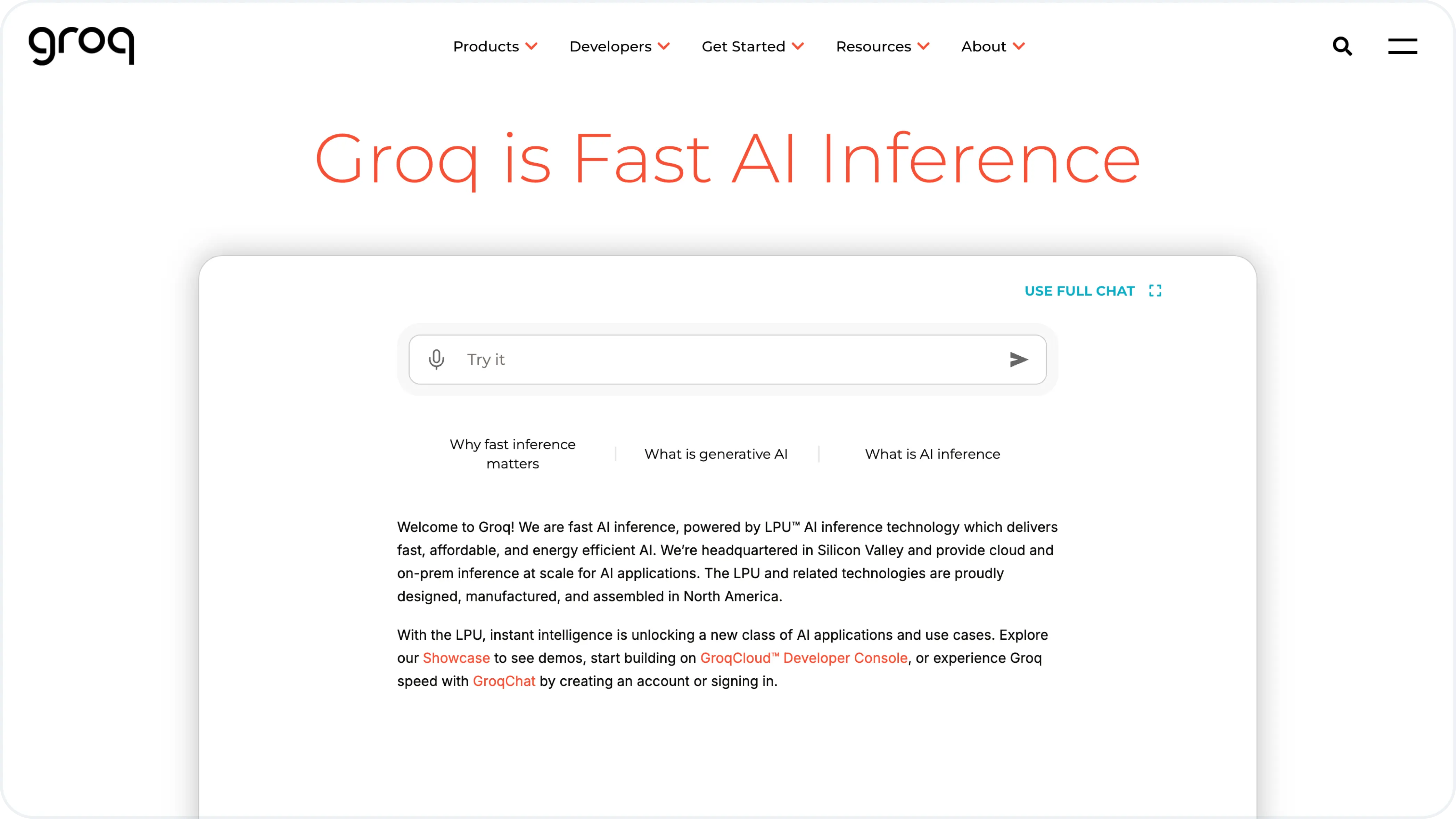
What is Groq?
Groq specializes in hardware optimized for high-speed inference. They developed a specialized chip called the Language Processing Unit (LPU) for ultra-fast AI inference that significantly outperforms traditional GPUs in speed and efficiency for AI model processing (up to 18x faster). Get started.
Why do companies use HuggingFace?
Performance & Scalability: Groq scales exceptionally well in performance-critical applications. In addition, Groq provides both cloud and on-premises solutions, making it a suitable option for high-performance AI applications across industries. Groq is suited for enterprises that require high-performance, on-premises solutions.
HuggingFace Pricing
Geared towards enterprise solutions with a focus on speed and efficiency.
Bottom Line
If ultra-low latency and hardware-level optimization are critical for your application, using LPU can give you a significant advantage. However, you may need to adapt your existing AI workflows to leverage the LPU architecture.
7. DeepInfra
Best for: Hosting AI models in the cloud. For large-scale AI applications.

What is DeepInfra?
DeepInfra is a platform for running large AI models on cloud infrastructure. It’s easy to use for managing large datasets and models. Cloud-centric approach, best for enterprises needing to host large models. Get started.
Why do companies use DeepInfra?
Simple & Scalable: DeepInfra’s inference API takes care of servers, GPUs, scaling and monitoring, and accessing the API takes just a few lines of code. It supports most of OpenAI APIs to help enterprises migrate and benefit of the cost savings. You can also run a dedicated instance of your public or private LLM on DeepInfra infrastructure.
DeepInfra Pricing
Usage-based. Pricing models differs depending on the model used. Some language models uses per token pricing. Most other models are billed for inference execution time.
Bottom Line
DeepInfra is a good option for projects that need to process large volumes of requests without compromising performance.
8. OpenRouter
Best for: Developers and researchers looking for a variety of models with an intuitive user experience.
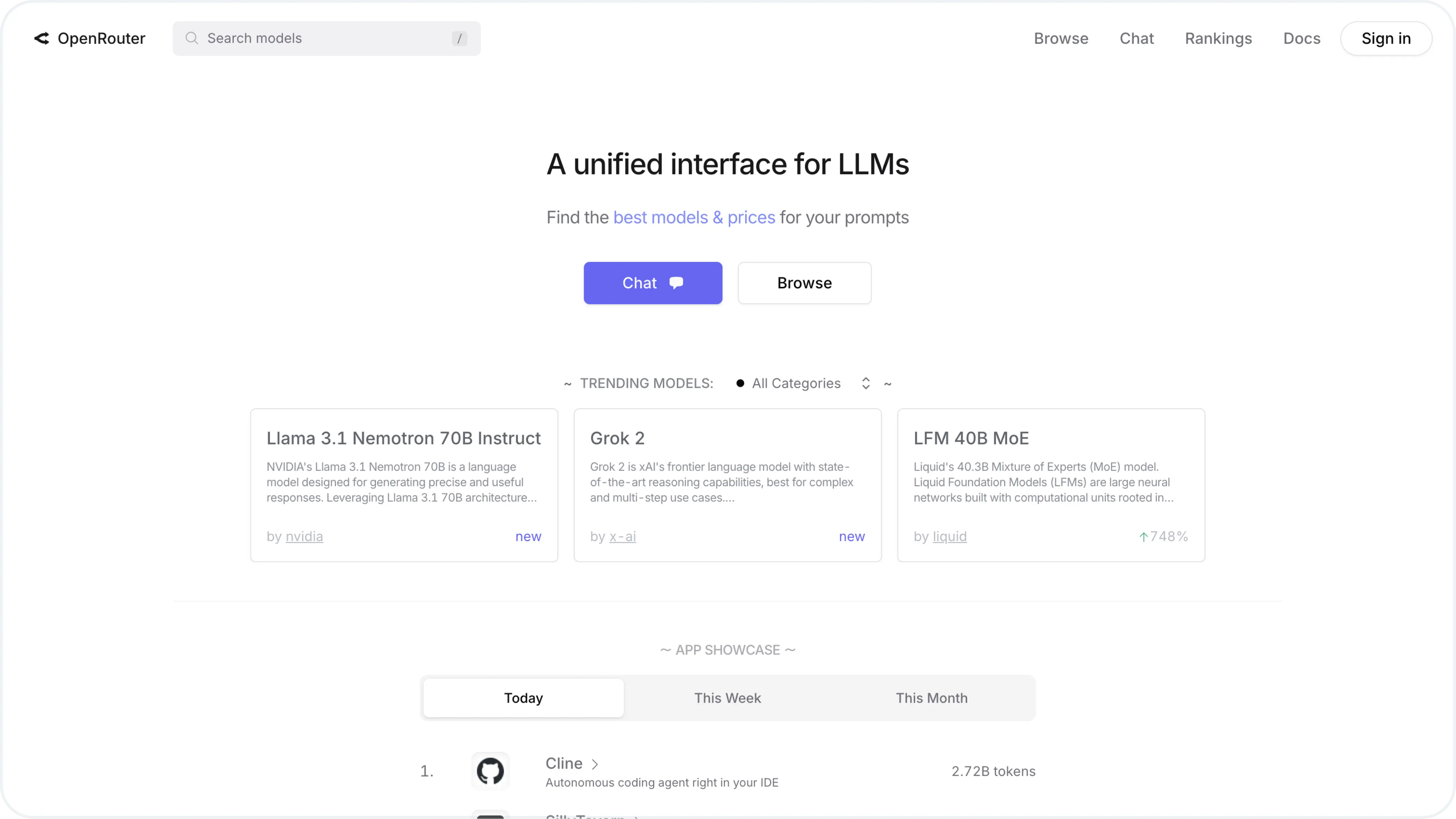
What is OpenRouter?
OpenRouter is a unified platform designed to help users find the best LLM models and prices for their prompts. OpenRouter Runner is the monolith inference engine built with Modal that powers open-source models that are hosted in a fallback capacity on OpenRouter. Get started.
Why do companies use OpenRouter?
Intuitive & flexible pricing: OpenRouter has a remarkable user-friendly interface, and a broad range of model selection. It allows developers to route traffic between multiple LLM providers for optimal performance, which is ideal for developers managing multiple LLM environments.
OpenRouter Pricing
Pay-as-you-go model and subscription plans. For pay-as-you-go, visit OpenRouter’s Models page to see the respective pricing per million input and output tokens by models. For monthly or annual subscription plans, OpenRouter does not publicly disclose specific pricing information.
Bottom Line
OpenRouter is excellent for developers who want flexibility and ease in switching between different LLM providers. If you anticipate the need to test or use multiple models without the hassle of integrating separate APIs, OpenRouter simplifies that process. However, there may be limited customization as some models are less advanced.
9. Lepton AI
Best for: Enterprises that require scalable and high-performance AI capabilities.

What is Lepton?
Lepton is a Pythonic framework to simplify AI service building. The Lepton Cloud offers AI inferencing and training with cloud-native experience and GPU infrastructure. Developers use Lepton for efficient and reliable AI model deployment, training, and serving, and high-resolution image generation and serverless storage. Get started.
Why do companies use Lepton?
Speed & developer-friendly: The platform offers a simple API that allows developers to integrate state-of-the-art models into any application easily. Developers can create models using Python without the need to learn complex containerization or Kubernetes, then deploy it within minutes.
Lepton Pricing
Pay-by-usage and subscription model. The free plan currently supports up to 48 CPUs + 2 GPUs concurrently, while each serverless endpoints cost by 1 million tokens. Visit Lepton’s Pricing page for details.
Bottom Line
Lepton can be a good fit for enterprises that require fast and efficient language processing without heavy resource consumption.
10. Perplexity AI
Best for: AI-driven search and knowledge applications.

What is Perplexity?
Perplexity AI is known for its AI-powered search and answer engine. While primarily a consumer-facing service, they offer APIs for developers to access intelligent search capabilities. pplx-api is a new service designed for fast access to various open-source language models. Get started.
Why do companies use Perplexity?
Fast Inference & Reliable Infrastructure: Developers can quickly integrate state-of-the-art open-source models via familiar REST API. Fast inference with up to 3.1x lower latency than Anyscale using NVIDIA TensortRT-LLM on A100 GPUs. Perplexity also has reliable, battle-tested infrastructure used in Perplexity’s products. Perplexity is rapidly including new open-source models within hours of launch (Llama and Mistral).
Perplexity Pricing
Free and premium tiers available based on search volume. Pro users receive a recurring $5 monthly pplx-api credit. For all other users, pricing will be determined based on usage. Visit Perplexity Pricing page for details.
Bottom Line
Perplexity AI is suitable for developers looking to incorporate advanced search and Q&A capabilities into their applications. If improving information retrieval is a crucial aspect for your project, using Perplexity can be a good move.
11. AnyScale
Best for: End-to-end AI development and deployment and applications requiring high scalability.
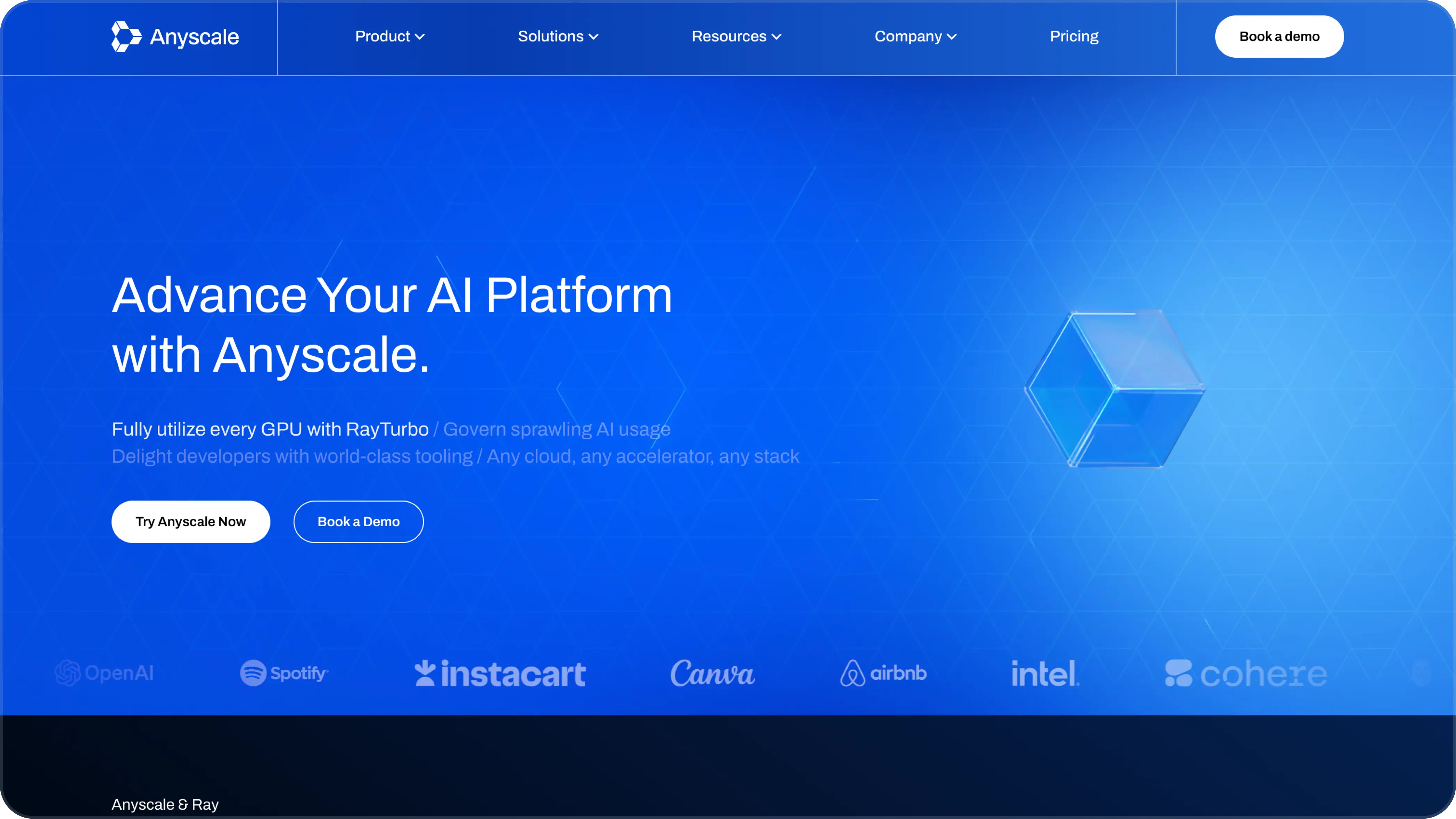
What is AnyScale?
AnyScale is a platform for building scalable AI and Python applications. AnyScale offers distributed computing, scalable model serving, and an end-to-end platform for developing, training, and deploying models. AnyScale is the company behind RayTurbo, a supercharged version of Ray — a framework for scaling Python applications — which is an AI Compute Engine optimized for performance, efficiency, and reliability. Get started.
Why do companies use AnyScale?
Enterprise-Grade Offerings & Developer Experience: AnyScale offers governance, admin, and billing controls as well as security and privacy features. AnyScale is also compatible with any cloud, accelerator, or stack, and have expert support from Ray, AI, and ML specialists.
AnyScale Pricing
Scales with usage, with enterprise-focused pricing for large teams.
Bottom Line
AnyScale is ideal for developers building applications that require high scalability and performance. If your project leverages Python and you need to scale seamlessly, Anyscale’s platform can be a good option.
Choosing the Right API Provider
Selecting the right LLM API provider depends on your needs, budget, and project goals. Here’s a quick recap to help you decide:
- For high performance and privacy: Together AI offers high-quality responses, faster response time, and lower cost, with a focus on privacy and scalability.
- For cost-effective solutions: Hyperbolic provides access to top-performing models at a fraction of the cost, with competitive GPU prices.
- For rapid prototyping and experimentation: Replicate simplifies machine learning model deployment and scaling, ideal for quick experiments and building MVPs.
- For NLP projects and open-source models: HuggingFace provides an extensive library of pre-trained models and a strong open-source community.
- For ultra-low latency applications: Groq specializes in hardware optimized for high-speed inference with their Language Processing Unit (LPU).
- For large-scale AI applications: DeepInfra excels in hosting and managing large AI models on cloud infrastructure.
- For flexibility across multiple LLM providers: OpenRouter allows routing traffic between multiple LLM providers for optimal performance.
- For enterprises requiring scalable AI capabilities: Lepton AI offers a Pythonic framework for efficient and reliable AI model deployment and training.
- For AI-driven search and knowledge applications: Perplexity AI specializes in AI-powered search engines and knowledge retrieval.
Remember to consider factors such as pricing, model variety, ease of integration, and scalability when making your final decision. It’s often beneficial to start with a small-scale test before committing to a provider for large-scale deployment.
FAQ
Q: What are LLM API providers?
LLM API providers offer cloud-based platforms for accessing and utilizing Large Language Models (LLMs) through Application Programming Interfaces (APIs). They allow developers to integrate advanced AI capabilities into their applications without having to train or host the models themselves.
Q: Why should I choose an LLM API provider instead of just using OpenAI?
While OpenAI is a popular choice, using alternative LLM API providers have several benefits:
- Lower costs, especially for high-volume usage
- Access to diverse, specialized models
- Easier fine-tuning and customization
- Better data privacy control
- Faster performance with optimized hardware
- Flexibility to switch between models or providers
- Support for open-source development
Q: How do I choose the right LLM API provider for my project?
Consider factors such as performance, cost, available models, scalability, ease of integration, specialized features, infrastructure reliability, data privacy, and community support. Your choice should align with your specific project requirements and budget.
Q: Are open-source models as good as proprietary ones?
Open-source models have made significant advancements and can often compete with proprietary models in performance. Providers like Together AI and Fireworks AI offer high-quality open-source models that can outperform some proprietary alternatives.
Q: What’s the most cost-effective LLM API provider?
Cost-effectiveness varies based on your usage. Hyperbolic claims to offer up to 80% cost reduction compared to traditional providers. However, it’s best to compare pricing models across providers based on your expected usage patterns.
Q: Which provider offers the fastest inference?
Groq specializes in ultra-fast AI inference with their Language Processing Unit (LPU). Fireworks AI also claims to have one of the fastest model APIs. However, actual performance may vary based on specific use cases and models.
Q: What if I need to fine-tune models for my specific use case?
Providers like Together AI, Replicate, and HuggingFace offer capabilities for fine-tuning models. Check each provider’s documentation for specific instructions on model customization.
Q: Can these LLM API providers handle multi-modal AI tasks (e.g., text and image processing)?
Yes, some providers offer multi-modal capabilities. For example, Fireworks AI supports models like FireLLaVA-13B for both text and image processing.
Q: What’s the difference between serverless and on-demand deployment options?
Serverless options, offered by providers like Fireworks AI, automatically scale resources based on demand. On-demand deployment gives you more control over the infrastructure but requires more management.
Q: Are these LLM API providers suitable for enterprise-level applications?
Yes, many of these providers offer enterprise-grade solutions. Anyscale, DeepInfra, and Together AI, for example, provide scalable solutions suitable for large-scale enterprise applications.
Q: How do I get started with using an LLM API provider?
Most providers offer documentation and quickstart guides. Generally, you’ll need to sign up for an account, obtain an API key, and then you can start making API calls to the models. Some providers also offer free tiers or credits for initial experimentation.
Questions or feedback?
Are the information out of date? Do you have additional platforms to add? Please raise an issue and we’d love to share your insights!